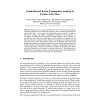Free Online Productivity Tools
i2Speak
i2Symbol
i2OCR
iTex2Img
iWeb2Print
iWeb2Shot
i2Type
iPdf2Split
iPdf2Merge
i2Bopomofo
i2Arabic
i2Style
i2Image
i2PDF
iLatex2Rtf
Sci2ools
GCB
2009
Springer
2009
Springer
Graph-Kernels for the Comparative Analysis of Protein Active Sites
Abstract: Graphs are often used to describe and analyze the geometry and physicochemical composition of biomolecular structures, such as chemical compounds and protein active sites. A key problem in graph-based structure analysis is to define a measure of similarity that enables a meaningful comparison of such structures. In this regard, so-called kernel functions have recently attracted a lot of attention, especially since they allow for the application of a rich repertoire of methods from the field of kernel-based machine learning. Most of the existing kernel functions on graph structures, however, have been designed for the case of unlabeled and/or unweighted graphs. Since proteins are often more naturally and more exactly represented in terms of node-labeled and edge-weighted graphs, we propose corresponding extensions of existing graph kernels. Moreover, we propose an instance of the substructure fingerprint kernel suitability for the analysis of protein binding sites. The perform...
| Added | 16 Aug 2010 |
| Updated | 16 Aug 2010 |
| Type | Conference |
| Year | 2009 |
| Where | GCB |
| Authors | Thomas Fober, Marco Mernberger, Ralph Moritz, Eyke Hüllermeier |
Comments (0)

